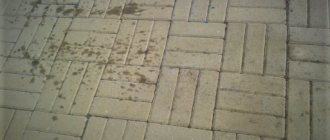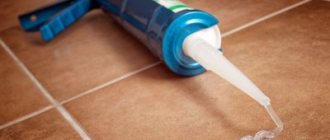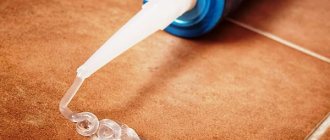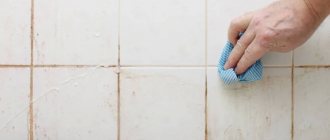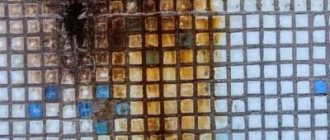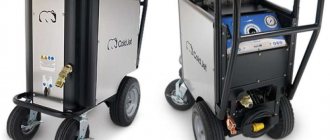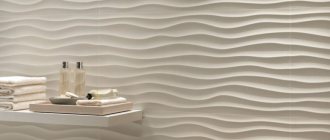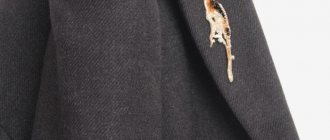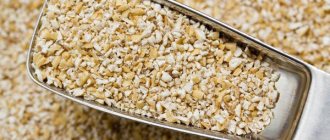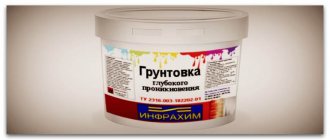In order to properly clean paving slabs, it is necessary to find out the nature of the contamination. This is easy to determine visually. Each specific case will require its own method of cleansing. For light stains, you can get by with simple cleaning using a brush and water. Difficult to remove stains will have to be removed using chemical compounds. To maintain cleanliness, you should regularly clean the paving stones without letting them get into a state of disrepair.
Determining the cleaning method
In order to choose the right product for cleaning the surface of paving stones, it is necessary to determine the nature of the existing contamination. It could be:
- white salt deposits;
- cement residues;
- stripes and traces of rubber;
- paint spots;
- mold or mildew;
- chewing gum or sticky foods;
- soot and ash;
- bitumen compounds and machine oil;
- remains of pet excrement.
For each of the listed types of pollution, there is its own, most effective way to clean paving slabs. And you should not use products and methods designed for some pollutants while removing others. This may turn out to be completely ineffective, and sometimes, on the contrary, it may worsen the situation.
When using chemicals to decontaminate paving stones, always use neutralizing agents and rinse the surface with plenty of water when finished.
Before washing paving slabs using chemicals, check the effect of the cleaning agent on it. To do this, you can use the stone left after laying or make a test in an inconspicuous place on the coating.
How often should paving slabs be cleaned?
Without maintenance, paving slabs quickly lose their attractive appearance. It is advisable not to wait until the coating is in a deplorable state, but to carry out cleaning as soon as individual dirt appears:
- To begin with, you can try to wash off the dirt from the hose with a strong stream of water. This is the easiest and fastest cleaning method, but it is not always effective.
- A more reliable method involves using a polymer brush and soapy water. It is better to use dishwashing detergent; it can easily cope with ordinary dirt.
- If the result is unsatisfactory, you will need to find out the nature of the contamination and use special equipment.
Twice a year (in spring and mid-summer), the paving stone manufacturer suggests doing a thorough cleaning to keep the pavement looking fresh longer. At the same time, individual cracked tiles are replaced and sand is poured into the cracks, if necessary.
Removing salt deposits
White salt stains may appear on the surface some time after laying the tiles.
You won’t be able to simply wash away the salt that appears on the tiles with water. Even if you scrub for a long time and carefully, after a while it will appear again.
Any salts are best neutralized by weak acid solutions or carbonate compounds. Treat the surface with a cleaning agent that contains these substances and wait 2-3 hours.
After this, rinse the surface well with water, wait until it dries well, and treat it with a hydrofumizer (deep-penetrating moisture protective agent). After this procedure, the appearance of salts should stop.
Destruction of fungal formations and mold
Errors in the design of drainage, the location of the tile covering in lowlands are factors due to which the tile is exposed to conditions of high humidity for a long time. The result can be problems that are dangerous to human health, such as mildew or mold.
You can resist them by using cleaning products with concentrated chlorine. The surface of the paving stones must be treated with a solution diluted with water (1:10), left for up to 40 minutes, then rinsed with water.
It is easy to get rid of fungus or mold protruding on the surface using the freezing method (the affected tile, wrapped in cellophane, is placed in the freezer for a day, then the dirt is removed and the surface is disinfected with an antiseptic). In the fight for cleanliness - the guarantee of health - burning has also proven itself well, when mold and mildew spores die from prolonged heating. Then the soot from heating with a blowtorch or gas torch is washed off with soap and water.
Removing paint stains
Usually the paint is removed with a spatula, but if that doesn’t work, it can be softened by removing old paint, which you can buy at a hardware store. The remaining stain can be removed with a solvent appropriate for the type of paint.
For oil paints this can be acetone or white spirit, and for water-based paints it can be regular warm water. In the most difficult cases, you can use a solution of hydrochloric acid to clean paint from paving slabs, but before that, check the reaction to it in an inconspicuous place. Acid may discolor tile surfaces.
To wash paving slabs, you need to use household chlorine-based bleach or dilute bleach in water, and then treat the affected area.
Sticky foods and chewing gum
You can fight such enemies of the purity and beauty of paving slabs in the following way.
Using a knife (spatula, etc.), clean the surface from dried (or frozen with a piece of ice) chewing gum, sticky candies, etc. The chewing gum is removed by first melting it by heating. After this, the paving slabs are treated with acetone and kerosene. Traces of sticky products, such as lard, are removed with water and detergent, as well as alcohol.
Removing bitumen stains and machine oil
Bitumen stains can appear on paving stones if waterproofing work is not carried out carefully. They can be removed using white spirit or acetone, which is a solvent for bitumen compounds.
But when dissolved, a bitumen primer will be formed, which is a deep-penetrating primer. Therefore, bitumen stains can only be washed off on dense tiles.
If the material is porous, then bitumen cannot be dissolved or heated. It is necessary to take sandpaper and gradually peel off the contaminated area.
How can you remove machine oil from paving slabs? Yes, the same acetone and also gasoline. If it is not possible to remove them completely, then the remains can also be burned off with a blowtorch.
Weeds, moss, lichens
If weeds have grown between the tiles, remove them by hand or using garden tools. Metal tools should be used carefully so as not to damage the paving stones themselves. Typically, vegetation is cut with scissors as close to the roots as possible.
Aggressive, difficult-to-remove weeds are treated with herbicide, and then the tiles are washed with clean water (after a few hours). Opponents of chemistry can pour boiling water into the cracks.
We recommend: The architect explained why a window was needed between the toilet and the kitchen: it was the key to survival
Moss grown on the tiles is removed mechanically using a spatula or scraper. To prevent the appearance of mosses and lichens, the tiles are treated with a solution of iron and ammonium sulfate. The same composition will help protect the tiles from mold.
Flushing away pet feces
Pets can relieve themselves directly on the pavement, since for them it is the same ground as everything else around them. And even after cleaning, the remains of their feces can leave stains and an unpleasant odor. The question arises: how to clean paving slabs from such contamination?
Such residues can be removed using a warm soapy solution and subsequent treatment with bleach, which contains chlorine.
Advantages of Concrete Parking Grid
Professional design of the parking lot makes the structure a full-fledged element of the local interior.
- The decorative capabilities of the exploited lawn grass stand are almost exhausted, so the interest of country house owners in new materials and technologies for their installation is understandable.
- Invented in the middle of the last century, the concrete parking grid received a rebirth after the development of vibrocompression technology. Additional processing makes it possible to increase the strength and moisture-freeze resistance of the concrete structure several times.
The branded concrete lawn grating for parking can be successfully used for quite a long time in difficult conditions of local loads, dampness and temperature changes. Today, the warranty life of concrete grating products is 30 years.
Order professional installation of paving stones from us right now!
About safety and environment
When working with acids, chlorine and alkaline cleaning solutions, do not forget about your own health and safety. Such work is carried out using rubber gloves and a respirator. It is advisable to have safety glasses. After all, a flying drop, even with a small amount of acid, getting into the eye, can seriously damage it.
Before cleaning paving slabs with chemicals, consider the environment. It may happen that after cleaning the paving stones with chemicals, the grass on the adjacent lawn will turn yellow, and the beautiful flowers in the flower bed will wither. Therefore, give preference to mechanical cleaning methods, and use chemicals only as a last resort.
Types of cleaning
Methods for cleaning paving stones are divided into several types depending on the method of exposure. The method you choose depends on the time of year:
- Mechanical cleaning is usually used in winter to remove ice and fallen snow. For this purpose, wooden shovels, scrapers, and spatulas are used.
- Chemical cleaning is allowed only with the use of specialized products that cannot damage the coating itself. The composition must be applied to damp tiles. If the product is aggressive, it is better to try it first on an inconspicuous area.
- Wet and dry cleaning is carried out with a polymer brush. The pressure of the water jet must be adjusted. Too much pressure can cause chips and damage to the tiles.
- Thermal cleaning involves the method of exposure to hot steam. Sometimes contaminants are removed using an open flame, for example, using a gas burner. This must be done with caution; strong heating can lead to damage to the coating.
In winter, paving stones become fragile, so you should not use tools with a metal edge.
In the summer, it is necessary to remove complex stains in a timely manner; when fresh, any stains can be removed faster and easier. If a polluting liquid spills, it is better not to rub it with a rag, but to cover it with an adsorbent. For this purpose, you can use sand, sawdust, or cat litter. The particles that have absorbed the liquid are then swept away with a broom or broom.
